
Alan tells us how important our gardens have become to us, they bring family and friends together, are good for our Mental and Physical Health as well as connecting us to Nature.
Lots of us have challenging gardens which we would like to become our dream garden they are often in fact a disaster zone.
So this year Alan and his team David Domoney, Katie Rushworth, Frances Tophill and Danny Clarke are going to surprise some inspirational people who gardens are some of the worst they have ever tackled.
They will also share the secrets of how they do this, giving us good ideas to transform the chosen garden as well as in our own gardens.
'Welcome to Love Your Garden'.
We should all welcome Wildlife into our gardens and they too can be beautiful gardens.
Alan is in West Bromwich and there to surprise Peter Hill who is a wildlife enthusiast but you would not get that idea from his concrete covered back garden.

'Crumbs' says Alan
Peter thinks the local news is there for an interview about his fundraising for the local Children's Hospitals and Emergency Services, when Alan creeps up on him to surprise him.

A shocked Pete bursts into laughter as Alan introduces himself and quickly tells him he has never seen ponds like his before.
Pete says he no idea what to do with them!
Pete does a lot of charity work in Pubs and he has visited nearly 22,000 for charity to ask them to donate a pound and a pint!
Alan thinks this is a brilliant idea and good excuse to visit so many pubs.
This unique way of raising money started in the local pub with his Dad Joe and there was a map of 250 pubs so they decided to visit each one and get a pound from each!

A group of them including his Dad then started going further afield on 'pub trips' and so far nearly 22,000 pubs and 350,000 miles they have travelled to.
This has raised over £30,000 for Children's Charities says Wayne Hills, Pete's brother with every penny going to charity.

Kerry Hemus from the Midlands Ambulance Service says without donations from people like Pete they could not do the job they do saving lives.
Joe, Pete's Dad sadly died 7 years ago and he lives in Joe's old house and the ponds that were originally to house wildlife and Newts were unfinished and the waterfall never got completed.

Pete says Wildlife is important to him and he needs to get the News back in the pond so Alan says he and his team will come and do the garden for him.
He is overwhelmed and will take them for a pint, Alan asks if he needs to give him a quid too.
The Garden
The garden is 15 metres long, it was created 50 years ago by Pete's Dad and he created all the ponds and the surrounding concrete.
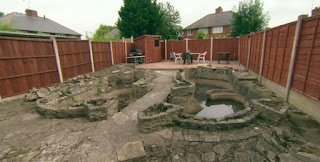
There is a bridge in the middle of the ponds that leads to an orange patio surrounded by an orange fence.
This is the main entertainment area and has a barbeque and a plastic table and chairs with a shed in the corner.

They have tried to complete the ponds and the waterfall with the help of his brothers but the job was just too big for them to complete.
Alan has no idea how and what they are going to do to the garden that must be a memory of his Dad Joe as well as for the wildlife and Newts.
Design Concepts
Alan goes to visit a garden in Kingswinford in Dudley which has a very impressive wildlife haven.

Right in the middle of the garden is a pond which is surrounded by planting and wildlife, this too is man-made and the planting is in tiers.
Right in the pond is the Rushes and as you get further out there are Evergreens, Conifers and Shrubs all scaling up in height, so lastly there are trees.
As well as Ponds being an asset to Wildlife so can planting the right plants and the plants next to the pond which can provide seedheads for food as well as shelter and shade.

The plants attract insects for mammals and birds to feed on.
Other ways to attract wildlife into your garden are cool, damp areas under trees with ferns and moss where amphibians and insects love to live.
The rotting timber of wood piles and stumps are the richest part of the garden.
Borders filled with flowers, attract all sorts of insects as well as give maximum impact with Tagetes, French Marigolds at the front, then Chrysanthemums Tapestry Rose and Dahlias in front of Golden Leaf Dogwood.
Everything wildlife needs, water, flowers, shade, sunshine, now Alan needs to get all this into Pete's garden, on a much smaller scale!
Alan starts on his plan but because there is so much of the pond that cannot be change he cannot start with a blank canvas on this makeover.

He plans to reduce the size of the pond so there is more room for plants that are a home for the wildlife.
Alan plans to add a waterfall and replace the bridge.
Frances is doing the area near the house for an amphibian friendly garden.
David job is at the end of the garden to create a beer garden thats also bee and butterfly friendly.
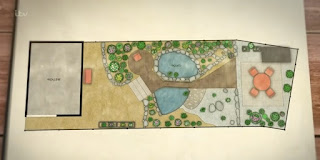
With the pond size reduced Alan wants to do 5 different wildlife habitats for Pete to enjoy and as a place he can remember his dad in.
A Work in Progress
The Contactors arrive to start work on the garden as well as Alan's Trusty Team of David Domoney and Frances Tophill.
There is a lot of concrete to break up and remove and the team sets to work clearing the garden.
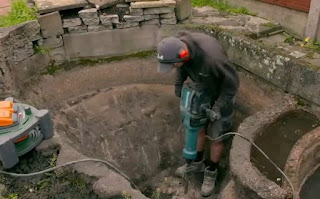
Work started on reducing the pond and the right hand one is 4 metres by 2 metres and this one is being filled so landscaping can be done on top.
David is breaking up brickwork to fill the pond so its a stable base to have soil on top. They have taken the top off the other pond and it is now level with the soil and in better proportions to the rest of the garden.
They have lined the other pond and now they have to fill it and for this they need a lot of water so David has got an industrial water truck to do that.
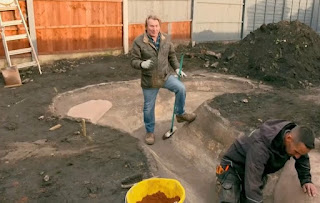
After just 30 minutes the pond is filled and he uses Lakeland Slate to cover the edge of the pond and he used it like dry stone walling round the edge.
Next David starts work on the bridge and Frances suggests he needs a mini troll to go under it and he moves on to do the paving for the seating area!

They get the new wooden bridge in place and all 3 of them test it to see if it is safe as a wind up duck sails under to Alan's amusement.
The area opposite the waterfall slopes so it's perfect for a Scree Garden and David is levelling out the pebbles and also outside the drinking area.
It is supposed to look like a mountain slope so they are also adding some giant boulders with sun loving plants between them.
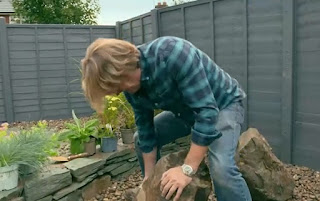
The pebbles help make it a low maintenance garden by stopping the weeds growing as well as helping with drainage.
The hard part is getting the rocks in the right position to look natural then planting the around them using plants that like dry conditions.
He starts by adding a small Pine Tree in the middle and he using a dwarf variety called Pinus Mugo, it can grow quite big but because it is slow growing it will take a long time to be any problem.
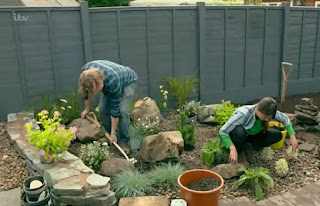
David plants this right next to a rock to give it a natural look and next he adds 3 ornamental grasses grouped together.
He using a favourite of his Festuca Glauca and in Latin Glaucus means light blue and if in Spring you have any dead leaves you cut them back and it regrows.
The blue will give interest all year round and look good with the other shades of green including the lighter coloured Euphorbias.
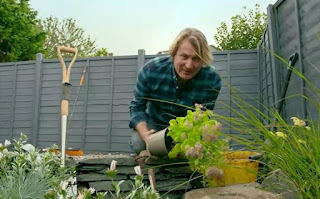
Sedum Spectabile 'Stardust' also known as an Ice Plant due to the foliage always feeling cold and it's a Sedum and flowers late for the Bees and Butterflies.
David final part is to turn the end of the garden into a drinking area for Pete as well as the birds so he is adding some trees along the back fence.
An Amelanchier grows to about 4 metres high and 3 metres wide and good at the back of a garden and the flowers are great for insects.
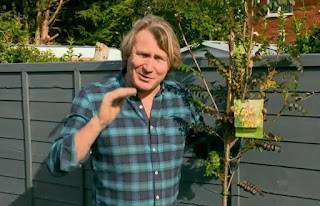
Next tree is a Sorbus or Mountain Ash and he is planting the variety Joseph Rock which has yellow berries in the Winter.
Trees should be planted to the same level as they are in the pot and it also needs a good firming with your foot to ensure its planted securely.
The Pub Garden needs to feel like a separate relaxing area so he in using planters to bring in more plants to the area.

After filling them with soil he adds an Escallonia for its pink flowers then some trailing Ivy and then Platycodon 'Astra Rose' which Bees love its pink flowers.
He adds several more planters and hanging planters and the area now feels enclosed by colour and greenery.
Frances is starting work on the area for Pete's beloved Newts and firstly she is digging a pit to make somewhere for them to hibernate over the cold Winter.
This is called a Hibernaculum and they are easy to make and first you dig out a meter wide trench that is 50cm deep.

At the bottom of this you bank up small branches/sticks old bricks and moss plus some leaves to rot down to keep it damp.
In a small garden you can create a habitat in an old wooden vegetable box you need a plastic pipe for access though.
Frances adds several pipes and encouraging Amphibians helps the garden too as Frogs will eat your slugs and Aphids for you.

Once it is all covered over in moss and leaves the whole area is covered with soil leaving the access pipes sticking out.
This area is in shade so once the soil is all carefully added over the top she edges it with some stones and plans a Prehistoric Reptile Jungle on top!
First she adds a huge tree stump which will be home to the Beetles, Woodlice as well as Fungi and Bacteria.
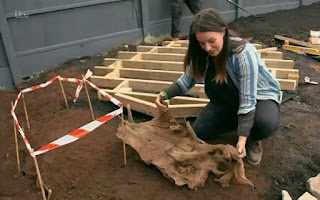
Next to the area is Pete's raised deck seating area so this will give him a good view of the new wildlife park.
Next she is planting ferns that are one of Frances favourite plants and they will do well in the shade and against the stump.
She has planted an non-native Fern which is a Blechnum called Volcano which is very tactile with red uncurling fronds.
This fern is an evergreen that will grow to a metre tall and look good all Winter.
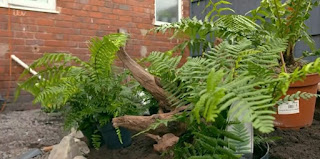
Ferns are quick growing so can be bought as smaller plants which are cheaper.
To continue the Jurassic look she is planting a Fatsia Polycarpa and is a relative of Ivy with very similar looking flowers.
Next plants are Hostas which come in all sorts of sizes and types and they all need cutting back in the Winter when the leaves die and they are alright in the shade.
The final touch is for Frances to paint the bottom of the deck black so it merges in with the bed she has created so the deck looks like it is floating above the plants.

It starts to rain as she cleans the deck of all the mud and Alan comes over for a look and he loves it and says so will the Newts.
Alan first job is the waterfall and the soil has already been banked up and he has to decide where the rocks are going.
He adds a bit of liner and the rocks need to be placed so it looks natural and the water flows properly and the only way to tell if its right as well as watertight is to try it!
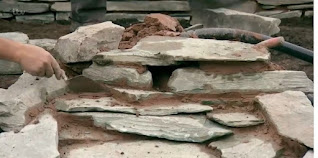
They have to wait for the mortar to dry but that also means they cannot change the design but Alan happy and confident it is all good!
While he is waiting he starts of the planting bed next to the pond and starts at the water's edge with small plants.
The nearer the fence the larger the plants and he has some Dogwoods that are a lovely colour and the Bees are attracted to the flowers.

Right next to the pond he has some trailing Campanula then next its some flowering Hebes and some Miscanthus Grass who birds love their seeds.
The Holly Blue Butterfly needs Ivy in the garden to lay its eggs on.
The time has come to test the waterfall but the water does not want to come out and Alan even takes a vote on if it is going too.

Sadly only Alan thinks it will as they try again and nothing happens.
Finally a trickle, then a burst of water flows down the waterfall and Alan is now smug.
Now the waterfall is working Alan plans to turn the rest of the area around it into a 'Retro Rockery'.
Alan starts by placing the low shrubs and dwarf conifers and to make it look natural the best plants to use are ones that naturally grow in rocky mountain areas.

Basically Alpines that are very tough and stay low growing, can cope with the cold and like well drained soil.
Plants like the Bell Heather Daboecia which is evergreen and he is planting varieties of Alpines that give all year round interest.
Rock Gardens are good for Wildlife as Butterflies can bask on the warm stones as well as the flowers being good sources of nectar and pollen.

Alan particularly likes a plant called Grevillea and they are better in a milder climate and the flowers often come out in Winter.
He is planting a creeping one called Grevillea Lanigera 'Red Salento' which has very strange looking flowers.
Alpines should not be buried too deeply or they will rot and also to be aware if you are adding grit or gravel of the planting height.
Another interesting plant is from New Zealand and called Raoulia which is a silver plant that grows in a mound so also has the name 'Vegetable Sheep'.

Once it is all planted he adds the gravel which will stop the plants being too close to the soil and rotting as well as help with drainage.
The Waterfall which Pete Dad always planned to add and the 'Retro Rock Garden' are complete.
Alan is in the wildlife pond with Frances, wearing waders, they are using rocks to build up a ramp at the sides of the pond for creatures to climb out if they fall in, like Hedgehogs.

This will also create hiding places for Amphibians.
They are also planting up the pond on the shelves around it and he starts with a Flag Iris is a marginal plant that just like their feet in water and they come already planted in perforated pots.
You place these on shelves and the roots will spread out into the water and Damselflies and Dragonflies like to perch on these and lay their eggs under the water.
When the nymphs hatch, they climb up the plants to shed their skins, before flying away.
The best time to plant Aquatic plants are late Spring, early Summer as the water is warming up and helps them get established.
Frances is planting a Mares Tail called Hippuris which is an oxygenator so this gets planted at the bottom and will help keep the water healthy.
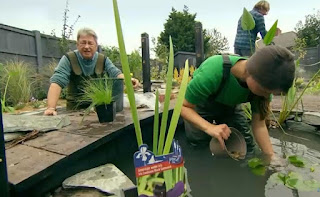
In the middle of the pond they add floating plants like Waterlilies and even though when planted they are often fully submerged in a few days the leaf stalks will make their way to the surface to float.
The final marginals give a huge splash of colour as they are Marsh Marigolds with their bright yellow buttercup like flowers, that are also known as Kingcup, as well as a Cyperus Papyrus, which Egyptians used to write on.

Frances has now realised the waders lent to her by David has a hole in them, how nice of him!
The pond was Pete's Dad dream so hopefully they have fulfilled his dream finally.
Alan wants the garden to appeal to wildlife all year round, so it needs to not only bring us interest but them too.
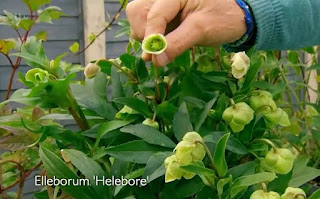
Hellebore's start flowering in late Winter and like dappled shade, so are great for underplanting trees and shrubs.
Buddleia or the Butterfly Bush are great for Summer flowers and they like the full sun and the flowers are full of Nectar when warmed by the sun.
A good tree for a wildlife garden is the Hawthorn which loses its leaves in the Winter, but in the Spring, they are back and followed by Blossom and then fruits or Haws/Rosehips in the Autumn, which birds love.
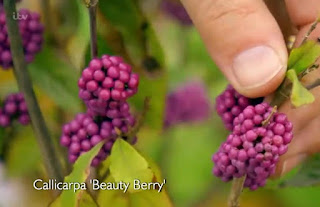
For Winter, he plants a Tutsan, a type of Hypericum, which has soft pink berries. but for bright berries you need a Callicarpa with artificial looking bright purple berries.
The berries last well into Winter also the leaves are deciduous.

With a few finishing touches including a inscribed bench in memory of Pete's Dad Joe, the garden, that was one of their biggest challenges, is complete.
The Grand Reveal
Peter open your eyes
'Ah, dear me' 'Ah dear' 'That's fabulous' 'Blooming hell, that's lovely, that is' 'I wish he was here, mate, to see it' 'He'd have been over the moon with this'

The garden is now a wildlife haven with the pond finally finished and taking pride of place in the garden.

The transformed pond and Alpine Rockery with Waterfall

A new bridge
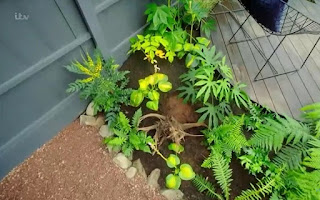
Mini Jurassic Park for Amphibians
Scree Garden

Pub Garden
Alan takes Pete on a tour of his garden as he spots all the things they have added for the wildlife.
He points out the pub sign made just for Pete 'The Inebriated Newt' which Pete loves as well as his new pub garden seating area.
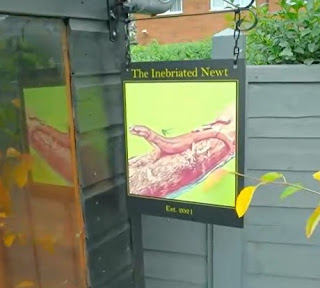
Pete says he never would have got it finished as he thanks Alan and wishes his Dad was here to see it.
Friends and family flock into the garden and I am sure the Beer will soon be flowing as they toast Pete new garden.
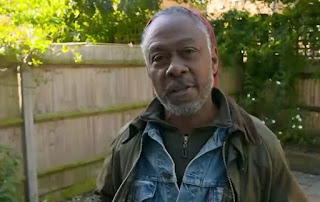
Danny Clarke is in an urban back garden which is small and empty but Danny has loads of ideas to make this more wildlife friendly.
The Garden
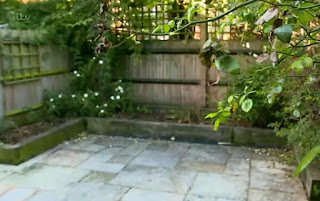
The plot is just 4 metres by 2 metres and Danny has no more than £400 to spend so he is enhancing and using a lot of the features already in the garden.
A Work in Progress
Danny first job is to use water to attract the wildlife and he plans to make a pond in a pot that costs £30 to buy the plastic pond bowl!
You could use an old sink, water butt or an existing bowl, all it has to be is water tight and it is the cheapest way to add a water feature to the garden.
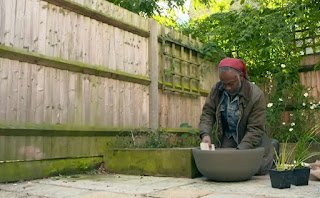
He is using some old tiles to make a couple of shelves so that the plants will be at the right height in the bowl.
He wraps them in old Hessian sacking to make them look better before placing the plants still in their aquatic pots into the bowl.
Danny is using marginal plants that live at the side of ponds so the shelves keep them from being fully submerged as they just like their roots in water.

He then puts some large stones at the bottom then fills the bowl with water and the plants he has used are Horsetail and a Variegated Dwarf Rush which are evergreen.
In the existing raised beds Danny is adding some wildlife attracting plants but adding Perennials and Grasses.
Danny points out an Monarda which is also known as Beebalm and the Bees love its scent.
Next he is constructing a shop bought living wall it is a modular system and each section cost about £17 each so you can make it to fit the space you have.
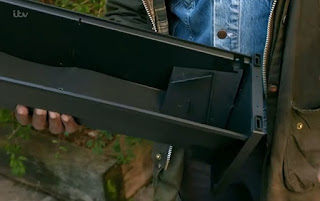
It is easy to put together and Danny attaches it to 2 timber posts rather than the fence and they will hold the weight of it better once they are concreted in.
You can get about 6 smallish plants in each trough and Danny plans to fill it with some Dwarf Snapdragons as well as Pansies and other Bee and Butterfly attracting flowers.
The owner of the garden has 2 young children so next Danny is making a Teepee play area using some free timber from recycled pallets.

Danny adds some finishing touches like a birdbox and garden sign and the mini makeover is complete.
The Grand Reveal
The dark shady end of garden is now a wildlife friendly haven for the whole family to enjoy.

A pond in a pot
Teepee play area

Wildlife attracting plants
All photographs are copyright of ITV.com
Previous Episode 🐟 Next Episode
Links
Landscape Team
JP Landscapes Ltd
Jason Williams

No comments:
Post a Comment